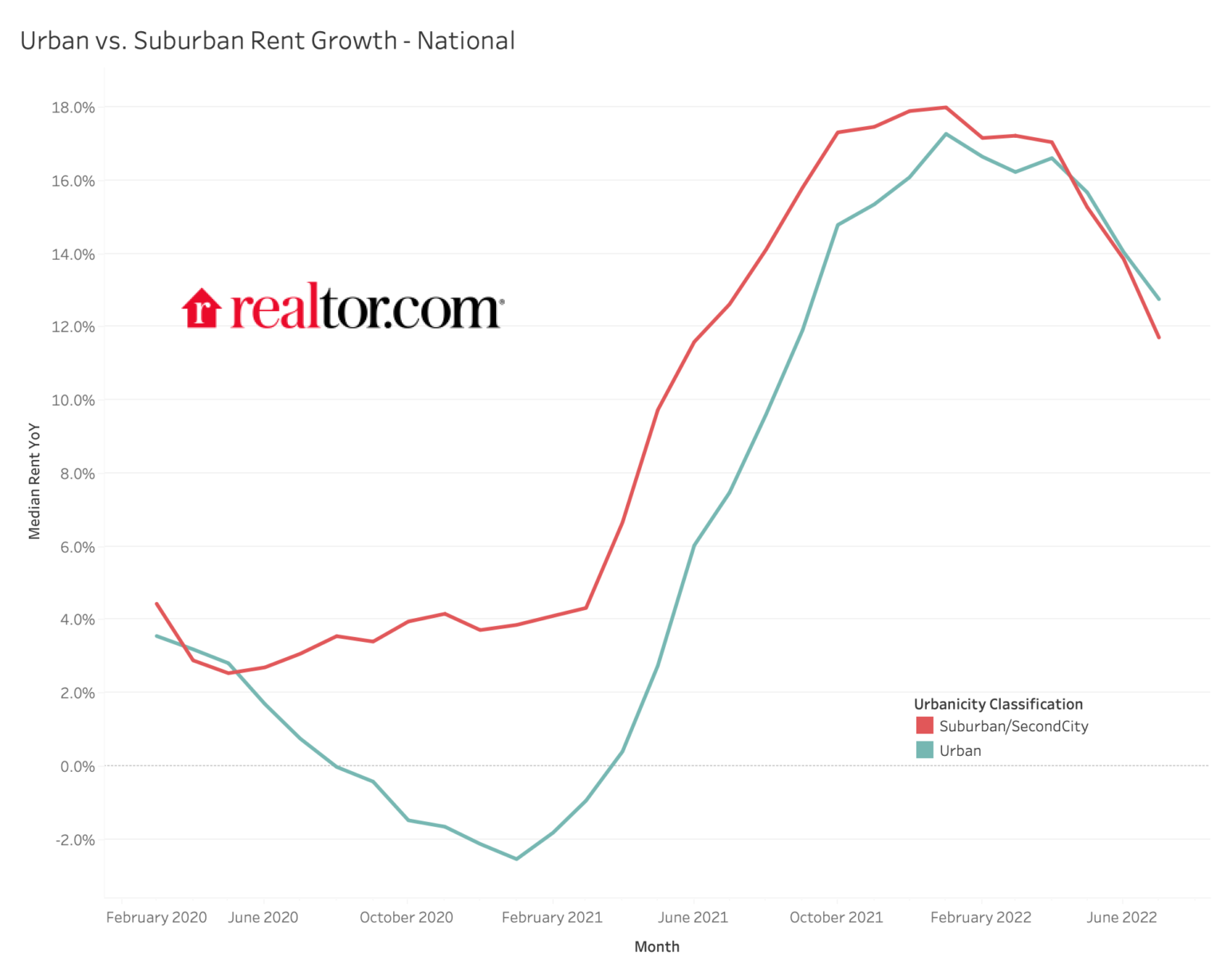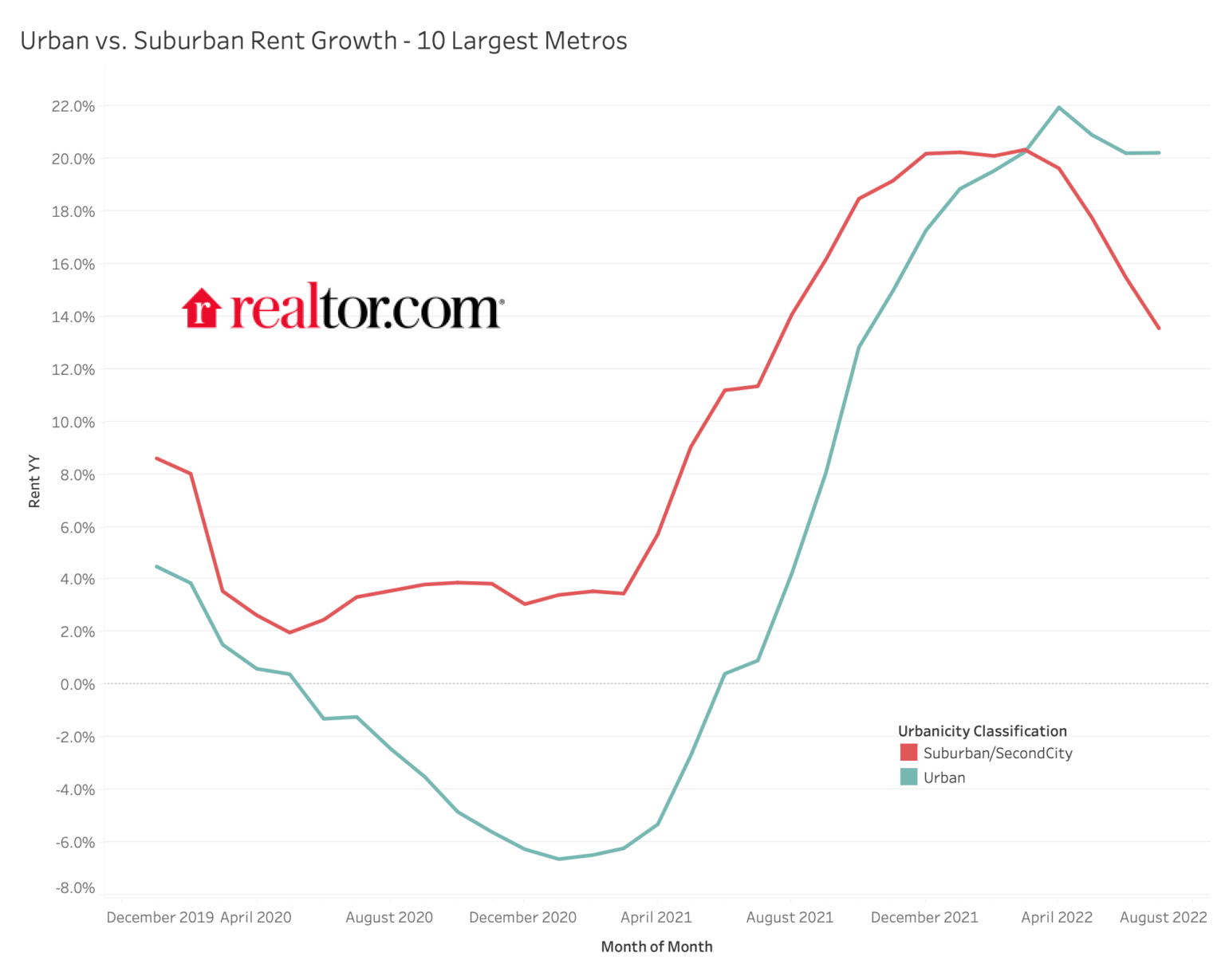According to Realtor.com's latest Monthly Rental Report [1], the rental price advantage of living in the suburbs vs. urban areas has shrunk by 52.9% compared to three years ago, driven by migration away from expensive city centers during the pandemic. As the U.S. median rental price hit its latest all-time high in July at $1,879, a new survey from Avail —a branch of Realtor.com— found that moving to a new rental has been costlier for renters, but there may be market cooling on the horizon as landlords adjust to renter budgets impacted by inflation.
"Whether in a downtown area or suburb, staying put or making a change, renters are stuck between a rock and a hard place when it comes to affordability. Compared to three years ago when rental price premiums were typically concentrated in urban hubs, renting is now nearly as expensive in the suburbs, where the rise in remote work has driven a surge in demand," said Realtor.com Chief Economist Danielle Hale. "At the same time, the days of smaller premiums for downtown rentals are numbered, as a return to in-office work and city life is sparking a relative uptick in urban rent growth. Put simply, renters are feeling it everywhere, but there may be some relief ahead. Survey findings suggest that landlords are adjusting their approaches to renters' tightening budgets, while July data shows rent growth is leveling off at a relatively cooler pace than in 2021."
 [2]National rents remain historically-high, across both urban and suburban areas
[2]National rents remain historically-high, across both urban and suburban areas
National rents reached a new high for the 17th month in a row in July, even as rent growth further moderated. So far this year, annual rent gains have been consistently getting smaller month-to-month, indicating a shift toward a more sustainable balance of rental supply and demand. On the one hand, this offers encouraging signs of relief, with more on the horizon as builders pick-up construction of apartments. On the other hand, renters continued to grapple with affordability challenges in July, driven by still-low vacancy rates that kept rents high and inflation (8.5%) that outpaced wage growth (+5.2%). Additionally, comparing today's rental trends to the 2019 market highlights how renters now face higher costs in a greater variety of areas, as renting in the suburbs no longer offers as much of an affordability advantage over big cities as it once did. While the rise in remote work and migration away from downtown areas gave suburban rents room to catch-up to urban rents earlier in the pandemic, the return to downtown life and offices is now driving an especially strong resurgence in big city rents.
- In July, the U.S. median rental price hit its latest new high ($1,879), but only increased by $3 over June as rent growth year-over-year (+12.3%) continued moderating to its slowest pace since August 2021 (+11.5%).
- Overall rents posted low double-digit gains over July 2021 levels across all unit sizes in July: Studios, up 14.3% to $1,555; one-bedrooms, up 12.2% to $1,745; and two-bedrooms, up 11.7% to $2,103.
- Among the 50 largest metros in July, rental prices grew most quickly year-over-year in the south and northeast, led by Miami for the 10th straight month (+26.2%). Rounding out July's five fastest-growing rental markets were New York (+25.4%), Boston (+24.8%), Chicago (+20.6%) and Orlando, Fla. (+20.4%).
- In four out of these five markets, urban rents grew at a faster yearly pace than suburban rents, most significantly in New York (+25.4 percentage points) and followed by Chicago (+15.7), Boston (+11.6) and Miami (+6.2); the growth rates were roughly even in Orlando (+19.5% vs. +20.3%).
- Nationally, July rent growth year-over-year was slightly faster in urban areas, up 12.8% to a median $1,927.5, than in suburban areas, up 11.7% to a median $1,821. This is a marked reversal from earlier in the pandemic in January 2021, when urban rent was falling by 2.5% while suburban rent was growing by 3.9%. Despite the recent resurgence in big city rents, shifts during COVID significantly shrank the gap between urban and suburban rents from July 2019-2022 – by 52.9% or $68 per month.
 [3]Avail survey finds renters still face rent hikes, but landlords may be relenting
[3]Avail survey finds renters still face rent hikes, but landlords may be relenting
Findings from the latest Avail1 Quarterly Landlord and Renter Survey underscore that rental affordability challenges are everywhere. Whether renewing an existing lease or moving to a new unit, the majority of surveyed renters experienced a rent hike over the past year, with new rentals proving costlier. At the same time, plans reported by landlords suggest that an end to the relentless rent surge may be in sight. Although the majority do expect to increase rents on at least one property, quarter-over-quarter trends indicate landlords are recognizing that renters are reaching their financial limits and beginning to adjust their business approaches accordingly.
- Among renters surveyed in July who have been in their current unit for 1-2 years, 52.4% have experienced a rent increase, by a median $160 per month (+13%). Of these renters, 77.1% are considering a move to a more affordable rental.
- However, whether in the rental or for-sale market, those looking for lower housing costs may not find much luck. Renters who moved within the past year reported 27% higher rents (+$300) than in their prior residence. Of renters planning to purchase a home, 72.7% are considering putting plans on pause in light of higher costs.
- More than half (60%) of renters reported that higher rents and household expenses are their biggest cause of financial strain, down from the April rate (66.1%). Additionally, a typical renter reported being able to put twice as much of their monthly take-home toward savings in July ($100) compared to April ($50).
- Findings from July's survey of landlords offer further potential signs that the worst of rental cost pressures may be behind renters. Although 72.1% of landlords reported plans to raise rents within the next year, the rate held steady over the previous quarter after jumping substantially from January (65.1%) to April (72.1%).
- When asked why they plan on raising rents, landlords cited higher costs for property management expenses, including tax payments (79.1%), maintenance and upkeep (75%) and utilities (45.9%). In the face of these cost pressures, the share of landlords who plan to buy new properties declined significantly in July (23.4%) from January (37.5%).
"Like renters, landlords are feeling financial pains from the inflationary economy. To help offset these higher costs while maintaining local ownership of rentals, our survey suggests that many landlords are making the difficult decision to raise rents. We're also beginning to see that landlords are less interested in growing their portfolios as they were in the past surveys," said Ryan Coon, Avail Co-Founder and VP of Rentals at Realtor.com. "It's important to remember that affordability remains a challenge for many renters. Those who are looking for support can access resources like free financial counseling through Avail's integration with the NFCC Renter Advantage program."
To read the full report, including more charts and methodology, click here [1].